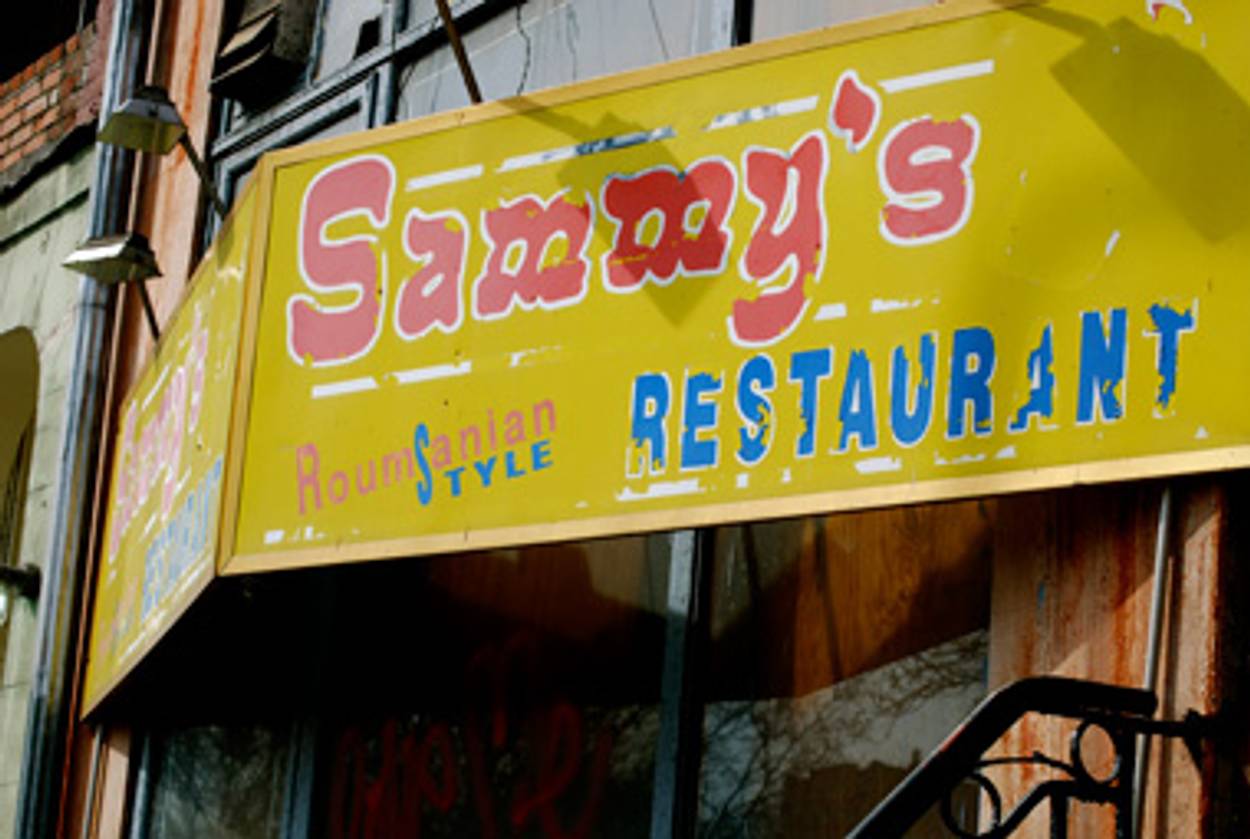In Its Prime
Recalling the heyday of the Romanian-Jewish steakhouse




With smoke from backyard grills perfuming our cities, the appetite once again turns to steak. This summer’s been extra meaty, thanks to Steak: One Man’s Search for the World’s Tastiest Piece of Beef, by journalist Mark Schatzker. To find out what makes a great steak Schatzker visited ranches and breeders across the United States, Japan, Argentina, and Europe, breaking down the science and culture of cattle rearing for taste with tremendous wit and detail, even going so far as to raise his own cattle. Having lived in Argentina for a few years (where I once ended the Yom Kippur fast with a barbecue), I know my way around a grill and a cut of beef, but I now see that I’m a rank amateur compared to Schatzker.
In the book, Schatzker documents a love of steak that he inherited from his father, a Polish Holocaust survivor who ate his first steak at a small-town northern Ontario restaurant in 1952 and hasn’t tasted anything as good since. The father’s experience was similar to that of many Jewish immigrants: In North America, they found that beef, a seldom-eaten luxury in Eastern Europe, was relatively cheap and readily available at local supermarkets. As newcomers settled into suburban houses with backyard grills, steak became a symbol of prosperity, a way of sharing in the affluence bestowed by citizenship in a new country.
Outside the house, the embrace and consumption of steak as emblematic of the American Dream manifested itself in the popularity of Romanian Jewish steakhouses, a culinary hybrid that’s all but extinct today. According to food writer Arthur Schwartz, whose grandfather was a waiter at Brooklyn’s Little Oriental steakhouse, Romanian steakhouses, many of them kosher, flourished around Delancey Street at the turn of the century, later moving uptown to the garment district (Lou G. Siegel’s was most famous) and out to the suburbs. In New York, he estimates there were a dozen or more at their peak in the 1950s, with several dozen spread out across the country in cities with large Jewish populations. They were a step up from the workingman’s delicatessen, a destination for a night out on the town but still within the reach of families who saved a bit.
Unlike the cooks in Poland, Russia, or Hungary who would prepare boiled, stewed, or even baked steaks, the Romanians knew how to grill, and in the United States they created restaurants where the main course, of flame-grilled marbled rib steaks or juicy skirt steaks (also called Romanian Tenderloin) would be complemented by favorite appetizers including chopped liver, knishes, and gribenes, fried chicken skins, that would be shared by the table along with the ubiquitous buckets of coleslaw and kosher pickles. The closest you got to salad was chopped liver tossed with sliced radish. There would be karnatzelach, a garlicky beef sausage made with baking soda, which gives it a springy texture and delectable crust.
The only establishment of this ilk still standing is Sammy’s Roumanian Steakhouse, on New York’s Lower East Side. Ample shtick is served there along with the food—a keyboardist plays bar mitzvah music, everyone gets a T-shirt—but the setup is genuine: rec-room basement décor, sarcasm-tinged service, bottles of seltzer and jars of liquid schmaltz on the table, some of the finest chopped liver known to man, and flame-broiled cuts of meat loaded with sautéed onions. It is greasy, filling, overpriced. It is a blast.
As Jews climbed the socio-economic ladder, their steakhouses began to emulate those of the WASPs. Out went the cramped, rec-room look, and in came dimly-lit palaces of wood paneling and plush carpeting, often in the suburbs to which Jews moved in increasing numbers. Cocktail bars took a spot by the front, along with coat-check girls. Traditional dishes like p’tcha (jellied calves feet) were replaced by double-baked potatoes and iceberg salads. Kosher concerns faded, and non-kosher cuts like sirloin and filet were added to menus, as well as pork chops and shellfish. At Moishes in Montreal, one of the few high-end Jewish steakhouses still operating, waiters wheel out dessert carts at the end of the meal piled high with profiteroles and hot fudge sundaes.
Whether you visited Seymore Kaye’s in Queens, Duke Zeibert’s in Washington, or dozens of similar joints in Miami, Detroit, Chicago, Cleveland, or Toronto, these were the haunts where real-estate machers and garmentos rolled deep in mink and sable and the parking lot overflowed with Cadillacs. This was Jewish dining at its most extravagant—with restaurants that belied their customers’ eagerness to be fully assimilated. Diners got French service, with tuxedo-jacketed waiters in white gloves, but the Yiddish taste remained, and the breadbasket was filled with challah rolls, pumpernickel, and fresh rye. Women in pearls picked at chopped liver, but there was a jovial atmosphere of back-slapping and kibitzing, and it never felt stuffy.
The Romanian-style steakhouse slowly died out, replaced on the low end of Jewish steak consumption by Israeli shish kebab restaurants and at the high end by fancy glatt kosher steakhouses, such as Prime Grill in Manhattan. Both iterations lack Yiddish kitchen flair. One is a multicultural mishmash, with less herring and more miso-glazed black cod, and the other is resolutely Middle Eastern. Fine dining for the younger generations of Jews now means sushi or Italian, and steak no longer means freedom as much as it means fat.
David Sax is a Toronto-based journalist and the author of Save the Deli.
David Sax’s latest book is The Future Is Analog: How to Create a More Human World, out this month.